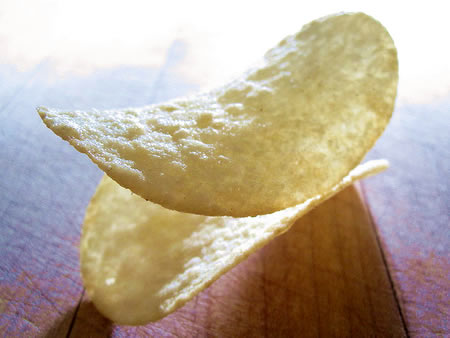Activity: Package the Pringle
http://www.flickr.com/photos/brunaferrara/ / CC BY 2.0
(Activity courtesy of Google and Charlie Lindgren, Wondergy)
Introduction:
The Pringles packaging challenge is a clever variation on the classic egg drop activity. For both, students attempt to produce a package design that will protect a delicate item, and they learn about the engineering design in the process.
For the Pringles challenge, students design a package for a single Pringles potato chip that will allow it to be sent through the mail and arrive intact. This is a great project to undertake with a partner school. Several groups have developed different versions of this challenge, including this 2010 Google sites competition, which offers specific rules and scoring, below.
Objective:
Students work individually or in small groups to design and test a package to safely ship a single Pringles Potato Chip through the US Postal Service to another school. Upon arrival, the chips will be evaluated and scored according to the process described below.
Goal:
To engineer the package to have the smallest mass and volume, while protecting the chip so it arrives at its destination undamaged.
Rules:
(adapted from those first used by Charlie Lindgren, now used by Wondergy)
1. Students will use 1 (regular) Pringles Potato Chip.
2. No substance my be applied to the chip, or the chip altered in any way.
3. The chip must be recoverable and edible (but please don’t eat it!) when received by the partner school.
4. Students will work individually or in small groups to design and test the package.
5. No pre-made Pringles containers should be used (ex. specially designed Pringles containers for lunch boxes, Pringles cans, etc)
6. All packages must be sent via the US Postal Service – First Class Mail. (please be aware the there may be a surcharge for small packages if you stamp them yourself. It may be advisable to bring them to the post office for stamping!) Packages sent using any other carrier may be disqualified.

7. Also be advised that there is a 3″ x 5″ limit on the size of the package, and a fussy postman may reject a smaller package. However in the past many, many packages smaller that 3″ x 5″ have been delivered, so getting a small package through the mail is part of the challenge).
8. Package must be clearly labeled on the outside with the sending school and group. (If special unpacking instructions are needed they should also be included).
9. Each participating school will send, receive and evaluate packages.
10. Each package must be clearly labeled “Pringles Challenge” and addressed to the receiving school, in care of the particular teacher.
11. The sending school MAY write only “Fragile” or “Handle With Care” on the package.
12. It is the responsibility of individual teachers to assure that results are accurate, and that they are exchanged in a timely manner.
Scoring:
- Mass – measured in Kg to at least 3 significant figures
- Volume – measured in cubic centimeters to at least 3 significant figures
- Intactness score of the chip as determined by the evaluating school, according to the chart below
| Perfectly Intact | Like it just left the factory |
100 Points |
| Slightly Damaged |
Cracked, but still in one piece |
50 Points |
| Chipped Chip |
Broken along the edges, but less than 5 pieces |
10 Points |
| Split Chip |
The chip is broken into two fairly equal pieces |
10 Points |
| Significantly Damaged |
Chipped and/or cracked into less than 20 pieces |
5 Points |
| Pringle Dust |
Too many pieces to count (more than 20) |
1 Point |
Overall Score
The overall score of the package will be used to compare packages. The formula for calculate the overall score will be as follows:
Overall Score = Intactness Score
(Mass in kg x Volume in cc)
Example:
a) A perfect chip = Intactness of 100
b) Mass = 256 grams or 0.256 kg
c) Volume = 250 cc (2.5 x 10^2)
Overall Score = (100/(.256 x 250)) = 100/64 = 1.56 (when rounded to 3 significant figures)
Extensions:
For another activities involving a cushioning challenge, see our egg drop lesson plan. Our activity on food packaging explores more fully the various requirements for packaging food and introduces students to the field of packaging engineering.
Filed under: Class Activities, Grades 6-8, Grades 9-12, Grades K-5









